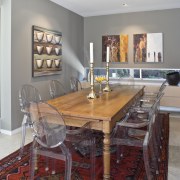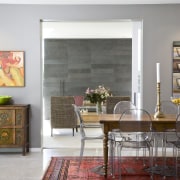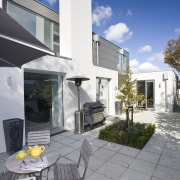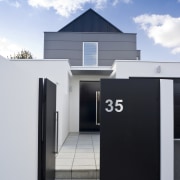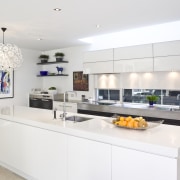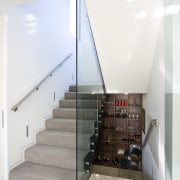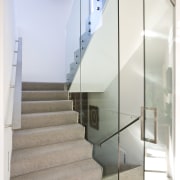Natural progression
Updating a traditional gable style links this house to the past as well as connecting it to a long-established neighbourhood
Building a new house in an established neighbourhood often works best when the structure is sympathetic to the local style. Modernising a traditional design is one way to solve the problem of blending in.
This two-storey house updates the gable style typical of the area, streamlining the classic look. The design is summed up in a mix of old and new. The conventional eaves disappear but the gable remains as the lines are smoothed to become crisp and angular.
After their children left home, the owners decided they wanted smaller, more modern residence. Their new house offers a fitting backdrop for a mix of new furniture and cherished antiques.
The clients desired a dwelling that combined the feel of the large, older houses filled with antiques where they once lived with a moderately sized modern house, says Kerry Mason, director of MAP Architects. The updated gabled house captured the essence of what they sought.
A soft palette provides a backdrop for the homeowners' furniture and art collection. Tones of grey and white are complemented by the colours of the built-in wooden shelving, Mason says.
"Muted tones give more flexibility for future acquisitions," he says.
At the entry, a hall opens to the kitchen and family room, followed by the dining and living rooms. To the left of the entry are a guest bedroom and ensuite, along with a study which could convert into another bedroom, so that all living can be on one level if required. Upstairs are the master suite and two bedrooms.
The ground-floor living spaces move directly from one to the next, without any corridors or passages to break up the flow, Mason says. Cavity sliding doors allow each room to be closed off to contain the heat during the winter or opened up into a single large space for entertaining.
These openings line up to frame a floor-to-ceiling lava-stone fireplace with a basalt hearth, which dominates the formal living room. The large grey stone surround holds the heat, then releases it slowly to provide more warmth.
On the east side of the room, a built-in bookcase provides ample display space. A thin window at waist height replaces the centre shelf on the lowest level. Repeated in the dining room and kitchen, the narrow windows make the best of the view over the paved garden. At night, lights from the garden turn these windows into a feature for all the rooms.

In an era of open-plan houses, the formal dining space is used almost daily. Particularly notable is the 19th-century French kitchen table, surrounded by transparent plastic Philippe Starck Louis Ghost chairs.
The owners combined the items because they liked the contrast between antique and modern. An antique rug and painted Tibetan chest paired with contemporary art on the walls continue this theme. Lights above the built-in buffet and in the ceiling gently illuminate the works.
Less formal is the combined kitchen and family room. The bright, white space is accented by a dramatic sunburst lighting fixture above the island, which functions as a breakfast bar in the morning.
Sunlight pours in through a long, thin skylight above the stainless steel sink and benchtop. The double ovens, raised slightly to make them easier to use, get a workout when the family visits.
Two sets of sliding doors open onto the paved garden, making it a simple task to bring food out from the kitchen for a barbecue next to the pool.
Credit list
Builder
Kitchen manufacturer
Roofing
Paints
Audiovisual equipment
Kitchen designer
Cladding
Tiling
Lighting
Window and door hardware
Heating system
Story by: Lori Nims
Photography by: Jamie Cobeldick Natural progression Updating a traditional gable style links this house to the past
Home kitchen bathroom commercial design
From farmhouse to farmstead
Walk this way – garden pathways to lead your thinking
Different rooms, same sky-blue ceiling


